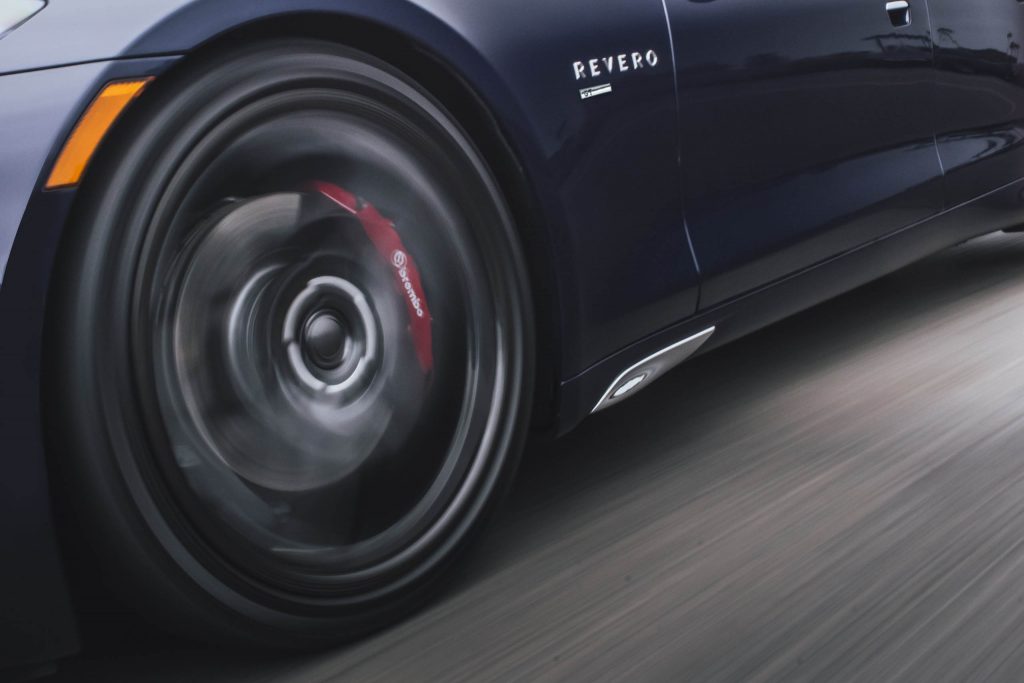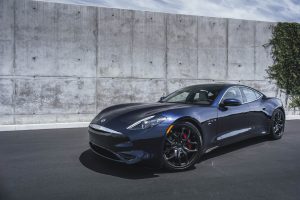10 mins | 1740 words
By: Jennifer Campbell
When the annual Consumer Electronics Show (CES) kicks off Jan. 7 in Las Vegas, Ottawa companies will be among those dazzling show-goers who gather to see the latest in consumer technologies.
CES showcases the most futuristic electronics tech every year, and this year, a unique Ottawa-based collaboration will be front and centre at Karma Automotive’s booth. The Southern California designer of the Revero electric vehicle, with up to 482 kilometres of range, will showcase its latest model, which is chock-full of Ottawa technology.
Sean Hazaray, who leads the mobility division at Karma, says there’s no other place in the world he could have accomplished what he wanted for this vehicle with his short time frame and allotted budget.
“Ottawa is a really unique city that has a lot of expertise in automotive software development,” Hazaray says. “It’s very special. It’s fronted by Blackberry QNX, and it’s grown because of a wave of startups that are all focused on automotive interior software. There are a lot of unique niche firms that specialize in this sector. It makes it a very attractive place for a company like us coming up north. I always come back because there’s a pride and quality here. I trust that the quality is going to be really good.”
Amongst leading companies, there’s an increasing awareness of this growing ecosystem in Canada’s capital; Ottawa is fast becoming a world-class hub for the automotive industry. That’s partly thanks to the city’s 1,800-acre private test facility for real-world demonstrations of connected and autonomous vehicles, the Ottawa L5. In addition to Blackberry QNX software, which has robust expertise in automotive software, the startups Hazaray noted, include companies such as Lixar, with its graphic design, infotainment and software skills; Arcane Four Studios, which integrates a vehicle’s technology with operational software; and Studio 63, whose industrial design brings all the physical pieces together. The results, in the CES collaboration, are demonstration vehicles that appear ready for the production lines of major manufacturers and that will give consumers real-world experiences that showcase the future of automotive. In short, consumers will be able to sit in cars that have facial recognition and artificial intelligence and give companies such as Karma live feedback on these innovations.
Karma started building electric vehicles with an extended range in 2014 and has as its mission to “get people excited about electric cars.” Hazaray notes that predictions suggest 40 percent of cars on the road in 2040 will be electric, but today, that number is less than one percent.
To power that mission, Ottawa has been a key player for the company.
“One thing that’s been exciting is that we can do these projects here that we can’t do anywhere else in the world,” Hazaray says. “For us, it’s really special to have a great group of team members in Ottawa that can deliver a product that is unlike anything else. There’s a lot of niche expertise that we’ve put together in a lot of these demonstration vehicles.”
And they’ve been working at the speed of, well, lightning-fast vehicles.
“In the past 14 months, we’ve done five cars in Ottawa,” Hazaray says. “The first car was actually done last year for CES in conjunction with Blackberry QNX, Studio 63, Lixar and Arcane Four. We then grew the collaboration and extended it to the New York International Auto Show, where we did a concept vehicle with a California company called Xperi.”
Between work with Karma, Xperi and others in California, a unique partnership between California and Ottawa is emerging and has so far been fruitful. Because of its consistent weather, California makers appreciate Ottawa’s test facilities, which puts self-driving vehicles through the kind of weather many of their customers across the northern hemisphere experience. And when the California companies are in town, they often call on Invest Ottawa to make introductions to small companies working Ottawa’s robust ecosystem.
“We’ve helped 74 companies so far,” says Kelly Daize, director of the connected and autonomous vehicle program at Invest Ottawa. “Blackberry QNX alone has integrated eight companies into its offerings.”
When Invest Ottawa started the Ottawa L5 as a project in 2016, the organization did so after seeing the strength of the Ottawa ecosystem in the autonomous and connected vehicle sector.
“We don’t make tires or cars, but we’re really strong in software, optics, sensors, semiconductors, embedded software, security and networking,” she says. “The Karma project really showcases the breadth of the ecosystem in Ottawa.”
Hazaray agrees.
“Ottawa has strong expertise in automotive software, but even beyond that, there’s a growing effort in autonomous testing and autonomous development and even, to some extent, manufacturing,” he says. “It has put a lot of effort into where automotive is going and, in some ways, some of the greatness that’s happening in Ottawa’s ecosystem is a well-kept secret.”

Karma Revero Concept Car
An additional element of the collaboration has been yet another high-profile team member — Amazon Web Services (AWS). The company collaborated on one of the three vehicles showcased at CES. This vehicle features machine learning and has the unique distinction of having brought together two tech juggernauts — AWS and QNX Blackberry.
“Some people see them as rivals, but they’ve been teaming up to create some really innovative technology,” Hazaray explains. “QNX software will guarantee the technology will work for the next 25 to 30 years no problem, and AWS provides the cloud. As cars are getting smarter and connected, the cloud is playing a bigger role. When you team up the cybersecurity prowess of QNX and the advantages of cloud from AWS, it opens up doors for what’s possible for OEM. It gives us a unique set of tools.”
The Ottawa-based partners in the project are equally as excited about how the city is driving connected and autonomous vehicle technology as they are about how the ecosystem is creating global partnerships with world-class firms. It’s contributing to the industry as a whole.
Jonathan Hacker, engineering director at Arcane Four, describes his company as an embedded systems integrator. It takes the technology from other players and provides what he calls “the embedded glue” to present it all in a way that’s compelling to their customers.
“The people you have access to — everyone you need to pull the entire experience together — are here,” Hacker says.
He highlighted that the partnership with Karma has been “really cool” because it integrates things such as machine learning and facial and gesture recognition and gives its customers a chance to test it in the market. His company can also play a role in vehicle production, he says.
“To do autonomous vehicles, you need various pieces of software from various partners,” Hacker says. “To do something as advanced as driving a vehicle autonomously, you need each partner to bring their best technology to the game and some way to bring those pieces of technology together. That’s what we do.”
Meanwhile, Studio 63 integrates technology into vehicles from an industrial design point of view.
“We take other people’s technology and showcase it so consumers can see what’s possible in the future,” says Miles Hammond, president and senior industrial designer at Studio 63. “We have three cars we’re sending to CES from Ottawa with several different technologies — everything from audio — we put 5.1 sound in a car and if you haven’t heard the demo, you must — to HD radio, visual, LIDAR [a surveying method that measures distance to a target with lasers and sensors.] All this technology we’re integrating into these cars so people can experience what the cars of the future will look like.”
Hammond says his company solves the problem of “how you make stuff look like it’s part of production.” To do that, it uses computer-aided architectural design to create housings that will integrate into the car. The company tackles everything from the electrical, audio and design and integration, but it’s the design and integration that makes its offerings unique.
“If our work is invisible to our clients’ clients, that means we’ve done our job,” Hammond says. “You can’t just have hardware, software and design. We have to pull on all these different partners to create a holistic experience in the car. Together we create this amazing experience. Because there’s enough of a hub in Ottawa, it’s like a stone [or a snowball] — once it starts rolling, more people jump on the bandwagon.”
Hammond explains that the end goal of the growing ecosystem is to create jobs and make cars safer and more enjoyable to drive — or, in the case of autonomous vehicles, not drive.
“You want someone getting in the demo car, and saying ‘when can we buy this car?’ That’s a win when you get a desire to be in this car of the future,” he says. “We want people to experience the future now. The further out we can extend that future, the more exciting it is. We judge our success by what happens at these shows, and they say yes, I’ve seen the future; it’s here now.”
The Karma project showcased at CES is just one such collaboration in Ottawa, with many more in the works.
“One of the wonderful things about working with Karma is that they’re looking at being the best in the world and to really drive innovation,” Invest Ottawa’s Daize says. “They’ve come here to the Ottawa area to accelerate that. They’ve done something really incredible under some really tight timelines.”
And as for the future of the Ottawa ecosystem?
“We’re at a real crossroads with automotive,” she says. “What’s going to happen when crashes become less likely and innovative companies such as Karma can get more creative with the body and physicality of the car? Ottawa is super well placed to lead in that area. We don’t make cars and tires, but what about 3D-printing cars? It’s coming. The next 10 years are going to be really, really exciting.”
More information:
The Ottawa L5 test facilities offer world-class integrated testing grounds for the safe implementation of CAVs. On-site, vehicle-to-everything (V2X) testing, validation and demonstration of technologies are enabled on both public and private test tracks in Ottawa’s true four-season climate. The Ottawa L5 testing facilities are equipped with GPS (RTK), dedicated short-range communications (DSRC), Wi-Fi, 4G/LTE and 5G telecommunications and networking infrastructure, making it the first integrated CAV test environment of its kind in North America.







